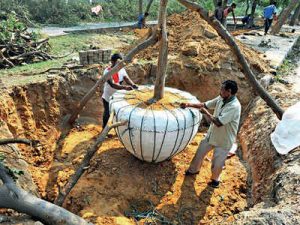Transplantation Of Trees:

The Central Public Works Department (CPWD) wants to transplant over 1,800 trees which are inside what used to be the Indira Gandhi National Centre for the Arts (IGNCA) complex, as part of the Central Vista redevelopment project.
- A tree cannot be transplanted by simply uprooting it and placing it in a pit dug elsewhere.
- The process involves multiple steps and requires significant expertise.
- First, the soil around the tree is dug up to isolate the roots. The big branches are lopped off, leaving only small shoots for regeneration.
- This is done to make transportation of the tree to the new location easier.
- The root system is covered with wet gunny bags to protect the roots and to keep the tree hydrated.
- The tree has to be first sent to a nursery to acclimatize to a new kind of soil, and to regenerate.
- Once new shoots start sprouting, the tree is lowered into a pit created in its new spot.
- The survival rate of a transplanted tree is about 50%. If it survives, the tree may take up to 10 years to grow a full canopy similar to what it originally had.
- Not all trees can be transplanted. While peepal, ficus, semal and sheesham are tolerant to transplantation, trees such as dak, palash, arjun, shahtoot and jhilmil are not.
- Any tree that has a tap root system cannot be transplanted, as the root goes deep into the soil, and it is not possible to isolate it without damage.
- Transplanting any tree with a trunk girth of more than 80-90 cm is not advisable as the tree cannot bear the shock, and will eventually die.




